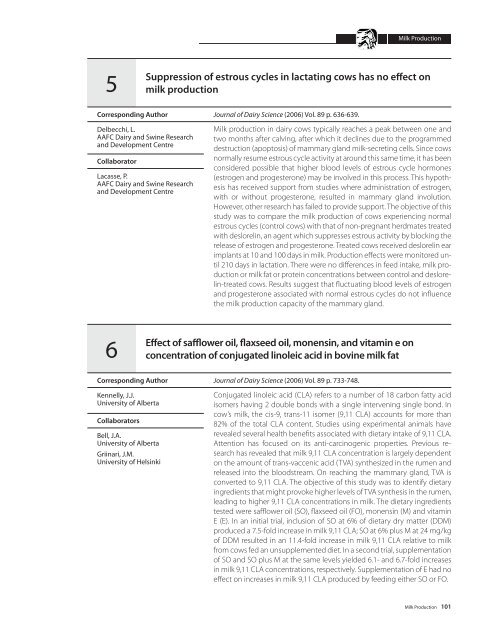A52-75-2007E.pdf - AgroMedia International Inc
A52-75-2007E.pdf - AgroMedia International Inc
A52-75-2007E.pdf - AgroMedia International Inc
You also want an ePaper? Increase the reach of your titles
YUMPU automatically turns print PDFs into web optimized ePapers that Google loves.
Milk Production5Suppression of estrous cycles in lactating cows has no effect onmilk productionCorresponding AuthorDelbecchi, L.AAFC Dairy and Swine Researchand Development CentreCollaboratorLacasse, P.AAFC Dairy and Swine Researchand Development CentreJournal of Dairy Science (2006) Vol. 89 p. 636-639.Milk production in dairy cows typically reaches a peak between one andtwo months after calving, after which it declines due to the programmeddestruction (apoptosis) of mammary gland milk-secreting cells. Since cowsnormally resume estrous cycle activity at around this same time, it has beenconsidered possible that higher blood levels of estrous cycle hormones(estrogen and progesterone) may be involved in this process. This hypothesishas received support from studies where administration of estrogen,with or without progesterone, resulted in mammary gland involution.However, other research has failed to provide support. The objective of thisstudy was to compare the milk production of cows experiencing normalestrous cycles (control cows) with that of non-pregnant herdmates treatedwith deslorelin, an agent which suppresses estrous activity by blocking therelease of estrogen and progesterone. Treated cows received deslorelin earimplants at 10 and 100 days in milk. Production effects were monitored until210 days in lactation. There were no differences in feed intake, milk productionor milk fat or protein concentrations between control and deslorelin-treatedcows. Results suggest that fluctuating blood levels of estrogenand progesterone associated with normal estrous cycles do not influencethe milk production capacity of the mammary gland.6Effect of safflower oil, flaxseed oil, monensin, and vitamin e onconcentration of conjugated linoleic acid in bovine milk fatCorresponding AuthorKennelly, J.J.University of AlbertaCollaboratorsBell, J.A.University of AlbertaGriinari, J.M.University of HelsinkiJournal of Dairy Science (2006) Vol. 89 p. 733-748.Conjugated linoleic acid (CLA) refers to a number of 18 carbon fatty acidisomers having 2 double bonds with a single intervening single bond. <strong>Inc</strong>ow’s milk, the cis-9, trans-11 isomer (9,11 CLA) accounts for more than82% of the total CLA content. Studies using experimental animals haverevealed several health benefits associated with dietary intake of 9,11 CLA.Attention has focused on its anti-carcinogenic properties. Previous researchhas revealed that milk 9,11 CLA concentration is largely dependenton the amount of trans-vaccenic acid (TVA) synthesized in the rumen andreleased into the bloodstream. On reaching the mammary gland, TVA isconverted to 9,11 CLA. The objective of this study was to identify dietaryingredients that might provoke higher levels of TVA synthesis in the rumen,leading to higher 9,11 CLA concentrations in milk. The dietary ingredientstested were safflower oil (SO), flaxseed oil (FO), monensin (M) and vitaminE (E). In an initial trial, inclusion of SO at 6% of dietary dry matter (DDM)produced a 7.5-fold increase in milk 9,11 CLA; SO at 6% plus M at 24 mg/kgof DDM resulted in an 11.4-fold increase in milk 9,11 CLA relative to milkfrom cows fed an unsupplemented diet. In a second trial, supplementationof SO and SO plus M at the same levels yielded 6.1- and 6.7-fold increasesin milk 9,11 CLA concentrations, respectively. Supplementation of E had noeffect on increases in milk 9,11 CLA produced by feeding either SO or FO.Milk Production 101





